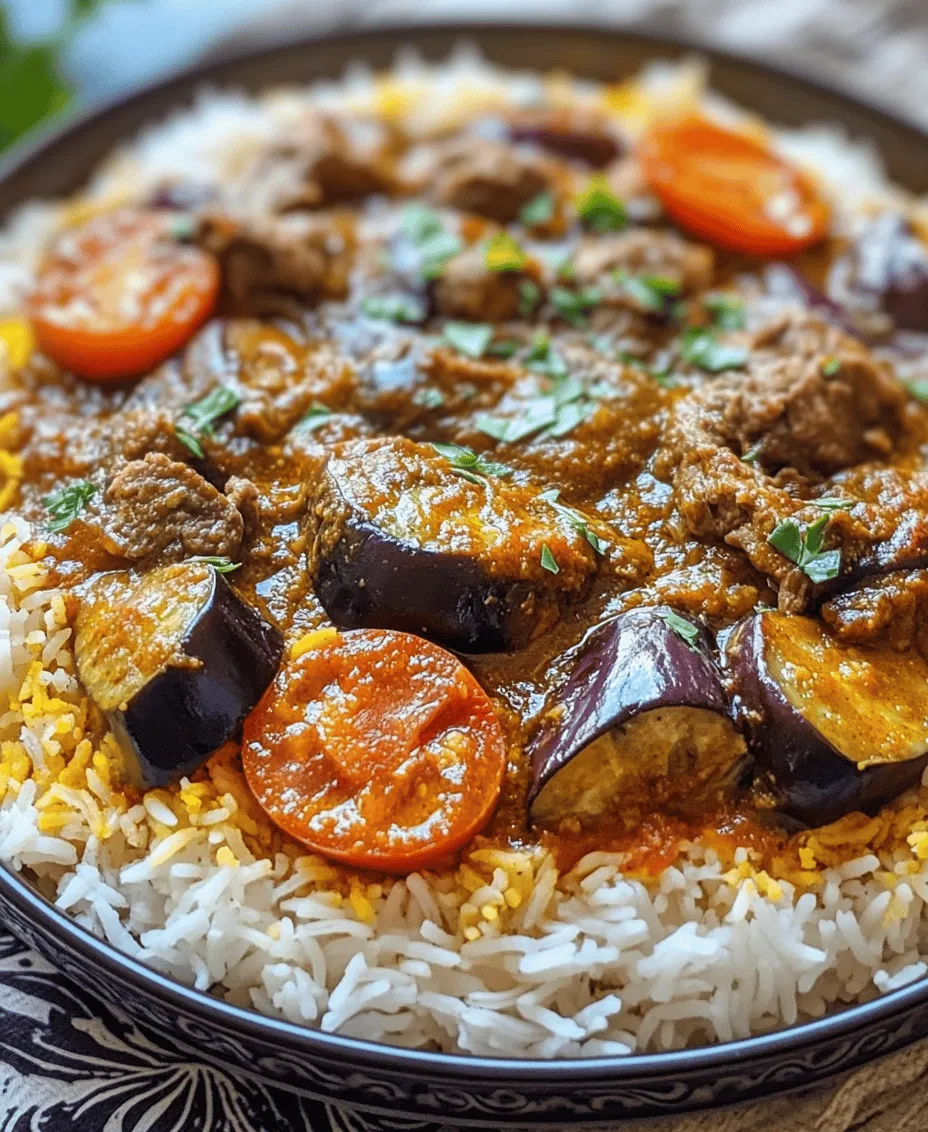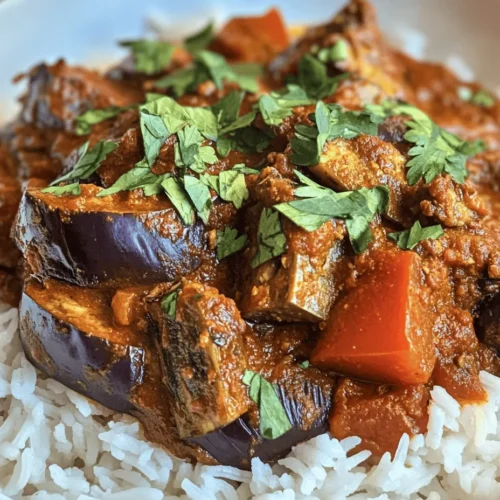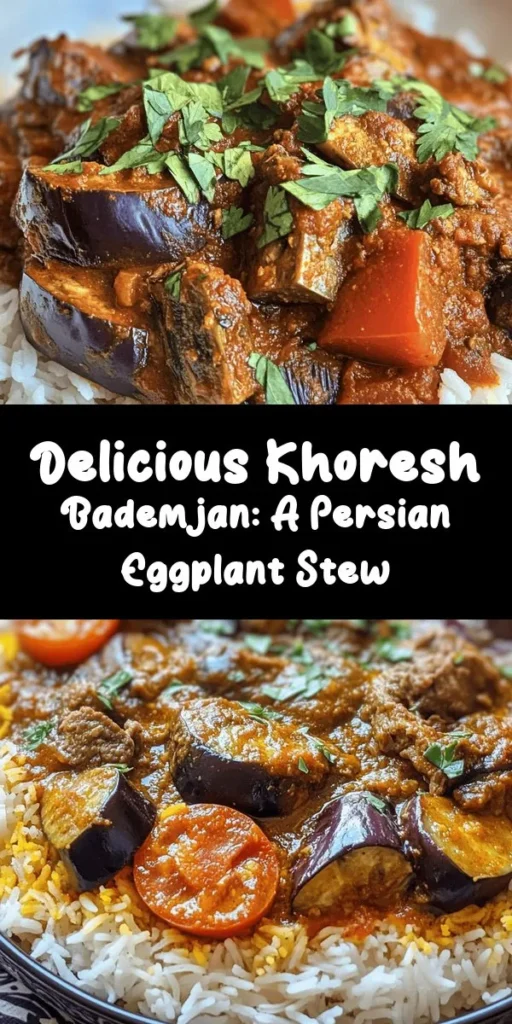Khoresh Bademjan, a sumptuous stew originating from the heart of Persian cuisine, captures the essence of comfort food with its rich flavors and aromatic spices. This iconic dish, primarily composed of eggplants, tender meat, and a medley of spices, is a staple in many Iranian households. Its significance extends beyond mere sustenance; Khoresh Bademjan embodies the warmth of Persian hospitality and the richness of its culinary heritage. Whether served over fluffy basmati rice or enjoyed on its own, this dish offers a deep, satisfying taste that resonates with both tradition and modern adaptations.
The Significance of Khoresh Bademjan in Persian Cuisine
Khoresh Bademjan is more than just a meal; it’s a celebration of Persian culture and its historical ties to agriculture and flavor. The term “Khoresh,” which translates to “stew” in Persian, reflects the cooking method that allows flavors to meld and develop over time. This dish is often prepared for family gatherings, festive occasions, and even everyday meals, showcasing its versatility and universal appeal.
The comforting flavors of Khoresh Bademjan stem from its combination of tender meat, creamy eggplants, and a blend of spices that create a luscious sauce. The dish holds a special place in the hearts of many Iranians, often evoking memories of home-cooked meals and family traditions. Its ability to adapt to various dietary preferences, whether incorporating meat or embracing vegetarian alternatives, adds to its charm. As more people explore plant-based diets, Khoresh Bademjan can easily accommodate these choices, making it a favorite among both meat lovers and vegetarians alike.
Understanding Khoresh Bademjan
To truly appreciate Khoresh Bademjan, it’s essential to understand its components and the cultural significance behind each ingredient. The dish’s name itself offers insight into its primary ingredient: “Bademjan,” which means eggplant in Persian. Eggplants have been a staple in Middle Eastern cooking for centuries, celebrated not only for their unique taste and texture but also for their nutritional benefits.
The term “Khoresh” signifies a slow-cooked stew, a hallmark of Persian cooking that allows for the melding of flavors. Persian stews are often characterized by their complex flavor profiles, derived from a careful selection of spices and herbs. In Khoresh Bademjan, the harmony of flavors is achieved through a combination of aromatic ingredients, which play crucial roles in elevating the dish.
Ingredients Breakdown
Eggplants: The star of Khoresh Bademjan, eggplants contribute a creamy texture and earthy flavor to the stew. When selecting eggplants, look for firm ones with smooth, shiny skin. Different varieties, such as globe or Italian eggplants, can be used, but it’s essential to choose ones that are not overly ripe to avoid bitterness. Nutritionally, eggplants are low in calories and rich in fiber, vitamins, and antioxidants, making them a healthy addition to any meal.
Onions and Garlic: These ingredients form the flavor base of many Persian dishes, including Khoresh Bademjan. Onions add sweetness and depth, while garlic provides a robust aromatic quality. Sautéing them at the beginning of the cooking process enhances their flavors, creating a rich foundation for the stew.
Meat Options: Traditional Khoresh Bademjan often features tender chunks of beef or lamb, which add richness and protein to the dish. However, for those seeking a vegetarian option, chickpeas or lentils can be excellent substitutes, providing a hearty texture and ample protein. The choice of meat or vegetarian alternative allows for flexibility in preparing this beloved dish.
Spices and Seasonings: The magic of Khoresh Bademjan lies in its spices. Turmeric, cumin, and cinnamon are frequently used, each contributing unique flavors. Turmeric brings warmth and a golden hue, cumin adds earthy notes, and cinnamon provides a hint of sweetness. These spices not only enhance the taste but also offer health benefits, such as anti-inflammatory properties.
Broth: The choice of broth—whether vegetable or beef—can significantly impact the flavor profile of Khoresh Bademjan. A rich beef broth will provide a deeper taste, while vegetable broth keeps the dish lighter and vegetarian-friendly. The broth serves as the cooking liquid, allowing the flavors to meld beautifully as the stew simmers.
Tomato Paste and Fresh Tomatoes: These ingredients are crucial for balancing the dish’s acidity and sweetness. Tomato paste adds a concentrated flavor, while fresh tomatoes contribute a juicy texture. Together, they create a harmonious sauce that coats the meat and eggplants perfectly.
Lemon Juice and Herbs: A splash of lemon juice enhances the dish’s brightness, cutting through the richness of the eggplants and meat. Fresh herbs like parsley or cilantro can be used as a garnish, adding a burst of freshness that elevates the overall presentation and flavor of the dish.
Preparation Steps for Khoresh Bademjan
The preparation of Khoresh Bademjan involves a few essential steps that ensure the dish’s flavors are well developed and the eggplants are prepared correctly.
1. Preparing the Eggplants: Begin by slicing the eggplants into thick rounds or elongated pieces, depending on your preference. To reduce any potential bitterness, sprinkle them with salt and let them sit for about 30 minutes. This process draws out moisture and bitterness from the eggplants. After 30 minutes, rinse the eggplants under cold water to remove excess salt and bitterness, then pat them dry with paper towels.
2. Searing Eggplants: In a large pot or Dutch oven, heat a generous amount of oil over medium heat. Once the oil is hot, add the eggplant slices in batches, ensuring not to overcrowd the pan. Sear them until they are golden brown on both sides, which will enhance their flavor and texture. Remove the seared eggplants from the pot and set them aside. This step is crucial, as it caramelizes the eggplants, adding depth to the dish.
Following these initial steps sets the stage for a flavorful Khoresh Bademjan. As the preparation continues, the combination of sautéed onions and garlic, tender meat, and aromatic spices will come together in a slow-cooked symphony of flavors. This dish not only nourishes the body but also warms the soul, making it a cherished recipe in Persian households and beyond.

Sautéing Onions and Garlic
The foundation of any great Khoresh Bademjan lies in the sautéing of onions and garlic. This step is crucial as it builds the flavor base for the stew. Start by heating a generous amount of oil in a large pot over medium heat. Once the oil is hot, add finely chopped onions and sauté until they turn translucent and slightly golden. This process typically takes about 8-10 minutes.
Next, add minced garlic to the pot and continue to cook for an additional 1-2 minutes until fragrant. The combination of sautéed onions and garlic not only provides depth to the dish but also enhances the overall aroma, making your kitchen feel inviting. This well-cooked base is essential, as it sets the stage for the meat (if using) and the other ingredients that will follow.
Cooking the Meat (Optional)
If you choose to include meat in your Khoresh Bademjan, the next step is to brown it properly. Use cubed lamb or beef for traditional recipes, as these cuts add rich flavor and tenderness. In the same pot with the sautéed onions and garlic, increase the heat to medium-high and add the meat. It’s important to not overcrowd the pot, so if you have a large amount of meat, consider browning it in batches.
Cook the meat until it develops a deep brown crust on all sides; this usually takes about 5-7 minutes. Browning the meat not only adds flavor through the Maillard reaction but also creates a wonderful base for the stew. Once the meat is browned, you can proceed to the next step by adding the tomatoes and broth.
Incorporating Tomatoes and Broth
Adding tomatoes and broth to your sautéed mixture is where the magic happens. If using fresh tomatoes, chop them finely; alternatively, you can use canned diced tomatoes for convenience. Stir the chopped tomatoes into the pot, allowing them to cook down for a few minutes. This will help release their juices and combine with the meat, enriching the stew’s overall flavor.
Now, add enough broth (beef or vegetable, depending on your choice) to cover the meat. This liquid is essential for creating a rich, flavorful stew. Bring the mixture to a gentle simmer and season with salt, pepper, and turmeric. The turmeric not only adds a beautiful color but also brings a warm, earthy flavor to the dish. Allow the stew to cook for about 30 minutes, giving the meat ample time to tenderize and absorb the flavors.
Simmering Techniques
Understanding the distinction in cooking times is crucial, especially if you are preparing a vegetarian version of Khoresh Bademjan. For meat-based dishes, a simmer of at least 1.5 to 2 hours on low heat is recommended to ensure the meat is tender and flavorful. For a vegetarian variant, using chickpeas instead of meat requires only about 30-45 minutes of simmering to allow the flavors to meld and the chickpeas to soften.
For both versions, keep an eye on the liquid level. You want a stew-like consistency, so add more broth or water if necessary. Stir occasionally to prevent sticking, and taste periodically to adjust the seasoning as desired.
Final Touches with Eggplants and Lemon Juice
As your stew simmers, it’s time to prepare the eggplants, which are a quintessential ingredient in Khoresh Bademjan. Slice your eggplants lengthwise and sprinkle them with salt. This will draw out excess moisture and bitterness. After about 30 minutes, rinse the eggplants and pat them dry.
In a separate pan, heat oil and fry the eggplant slices until golden brown and tender. This step adds a delightful texture and flavor to the dish. Once fried, gently fold the eggplants into the simmering stew during the last 20 minutes of cooking.
For a final burst of flavor, squeeze fresh lemon juice into the pot just before serving. This brightens the dish and complements the rich, savory notes of the stew beautifully.
Serving Suggestions
Khoresh Bademjan is best enjoyed alongside traditional Persian accompaniments. Here are some recommendations:
– Steamed Basmati Rice: The perfect base for your Khoresh Bademjan is a fluffy serving of basmati rice. Rinse the rice under cold water until the water runs clear to remove excess starch. Soak it in water for at least 30 minutes, then cook it in a pot with water and salt until fluffy. Serve it alongside the stew, allowing the rice to soak up the rich flavors of the sauce.
– Fresh Herbs: Garnishing with fresh herbs is a common practice in Persian cuisine. Prepare a platter of fresh herbs like parsley, cilantro, and mint. These herbs not only add a pop of color but also enhance the meal’s aroma and flavor profile. Encourage guests to sprinkle herbs over their servings for an extra burst of freshness.
– Optional Toppings: Consider serving Khoresh Bademjan with a side of yogurt or pickles. A dollop of plain yogurt can add creaminess and balance the dish’s richness, while pickles provide a tangy contrast that enhances the overall experience.
Nutritional Information
Khoresh Bademjan is not only delicious but also nutritionally balanced. The dish’s profile varies depending on whether you include meat or opt for a vegetarian version with chickpeas.
– Protein Content: If you choose to include meat, you can expect a robust protein content, with approximately 25-30 grams per serving, depending on the cut used. In the vegetarian version, chickpeas contribute a healthy dose of protein, roughly 15-20 grams per serving.
– Vitamins and Minerals: The dish is rich in vitamins and minerals sourced from the eggplants, tomatoes, and spices. Eggplants are a good source of dietary fiber, while tomatoes provide vitamin C and potassium. Additionally, the spices used, such as turmeric, offer anti-inflammatory benefits.
– Caloric Breakdown: A typical serving of Khoresh Bademjan (with meat) contains around 400-500 calories. The vegetarian version is slightly lower in calories, making it an excellent choice for those looking to enjoy a hearty meal without excessive caloric intake.
Cultural Context and Variations
Khoresh Bademjan holds a special place in Persian culture, often served during family gatherings and celebrations. The dish varies across different regions of Iran, with each family adding their own personal touch. For instance, some may incorporate saffron or dried limes for additional flavor, while others might adjust the proportions of spices based on family traditions.
In many Persian households, Khoresh Bademjan is a comfort food that evokes nostalgia, reminding individuals of gatherings around the dinner table. It embodies the essence of Persian hospitality, where sharing a meal is a cherished tradition.
Conclusion
Making Khoresh Bademjan is not just about following a recipe; it is about immersing oneself in the rich traditions of Persian cuisine. This hearty stew, blending tender meat or chickpeas with savory eggplants and aromatic spices, creates a warm and inviting dish that is perfect for family meals or special occasions.
As you prepare this delightful recipe, don’t hesitate to experiment with variations that suit your taste and dietary preferences. Whether you keep it traditional or add your own twist, Khoresh Bademjan is sure to become a beloved dish in your culinary repertoire. Share it with loved ones, and let the comforting flavors of this Persian classic bring everyone together around the table.



